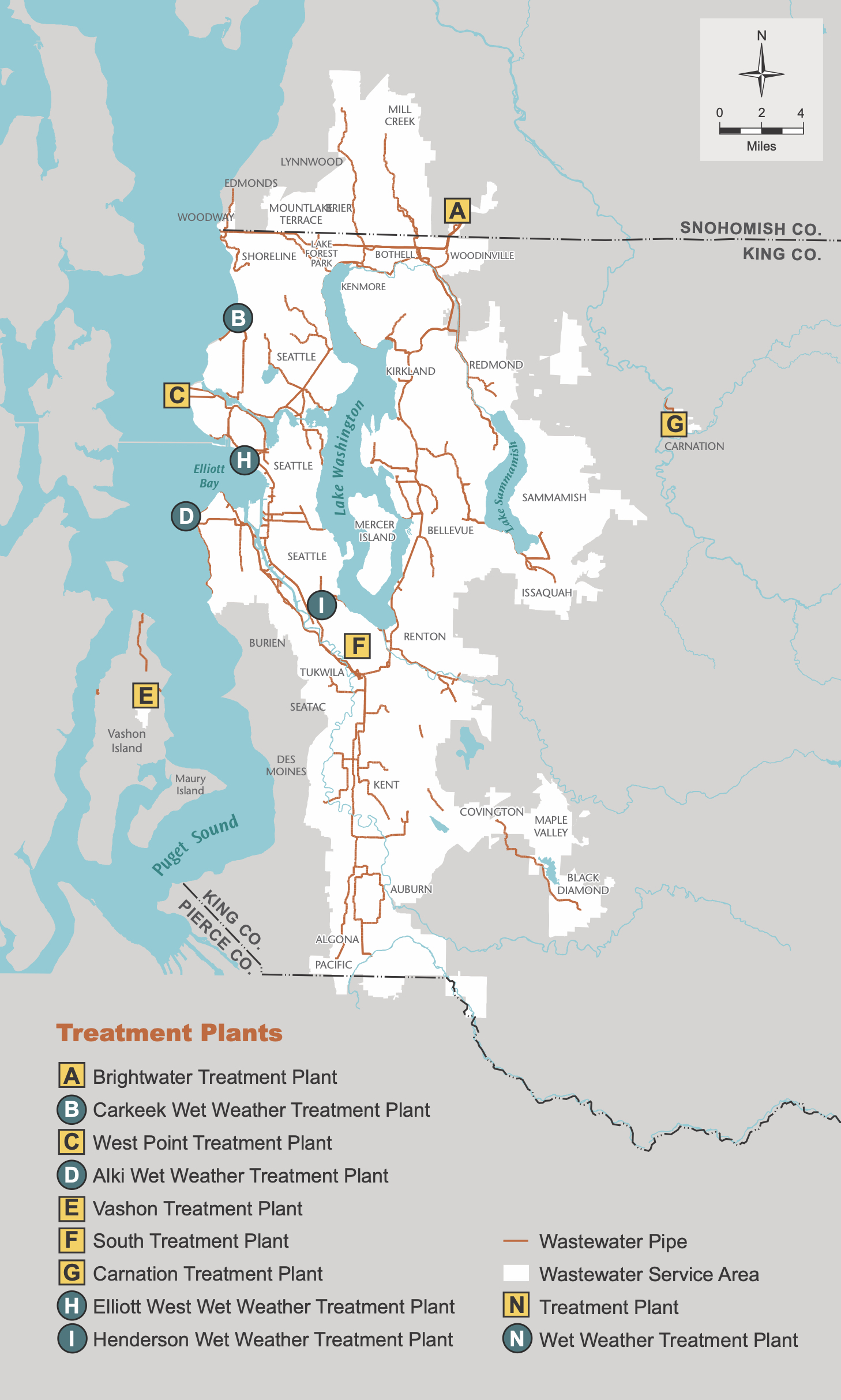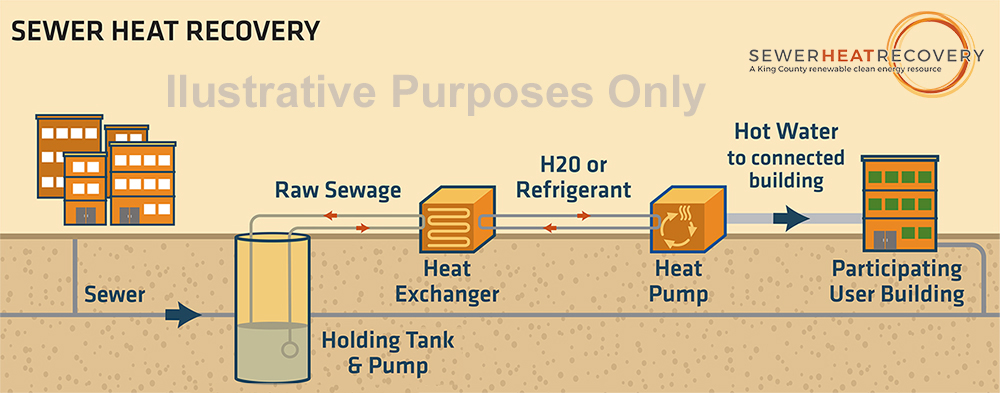To expedite the process of reviewing any future requests concerning the recovery of sewer heat, the WTD has developed a standard approach for use in such situations. “This time around we worked on creating a template user agreement, with general input from the developer community, that the council could consider, revise, and approve if they chose to,” Fiore says. With its September ordinance, the King County Council did just that. “That is what we have now, a template user agreement that we are ready to sign and that potential users can look at upfront to see if it’s a good fit,” Fiore says.
Substantial energy is used to heat water for domestic, commercial, and industrial purposes, and much of that energy literally goes down the drain. After hot water enters a collection system, its heat persists, offering a renewable, carbon-free source of thermal energy that has been harnessed only rarely in North America. Looking to promote the adoption of sustainable energy sources, King County, Washington — home to the city of Seattle — is conducting a pilot program to work with property owners and developers who want to recover unused waste heat in the county’s sewer system. At press time, the county was in the process of reviewing applications from entities interested in participating in the program.

In September 2020, the King County Council approved an ordinance authorizing the county’s Wastewater Treatment Division to enter into agreements for up to three sewer heat recovery projects. Both new construction and retrofit projects may participate.
Developing the pilot
The pilot program was developed in response to previous requests from private entities looking to recover waste heat from King County’s wastewater collection system, which comprises more than 390 mi of pipelines, trunks, and interceptors. “None of those projects had come to fruition for various reasons,” says Marie Fiore, a spokesperson for the WTD. This was because the council’s approval process took more time than a user had to make a decision about including such a system, she explains.

To expedite the process of reviewing any future requests concerning the recovery of sewer heat, the WTD has developed a standard approach for use in such situations. “This time around we worked on creating a template user agreement, with general input from the developer community, that the council could consider, revise, and approve if they chose to,” Fiore says. With its September ordinance, the King County Council did just that. “That is what we have now, a template user agreement that we are ready to sign and that potential users can look at upfront to see if it’s a good fit,” Fiore says.
In response to its request for applicants, the WTD received “multiple applications” and is reviewing them to ensure that they qualify, says Fiore, who declined to provide information regarding specific applicants and their proposed projects. Although the WTD had set a Dec. 18 deadline for applications to be submitted, any applications received after that date “will be retained and reviewed on a first-come, first-served basis until the pilot program is full,” Fiore says.
To be eligible to participate, a project must be located within King County’s service area or have access to its sewer system. The design of a potential project also must be at least 30 percent complete.
Multiple benefits
“Our new Sewer Heat Recovery program is a great opportunity for us to partner with King County commercial property owners,” said Mark Isaacson, the WTD director, in a Nov. 5 news release. “This technology will lower a connected building’s carbon emissions and help owners decrease their environmental footprint. Sewer heat recovery can also help owners and developers meet more stringent energy codes and give them a chance to leverage occupancy strategies that could attract tenants, buyers, and potential investors.”
The essentially continuous nature of wastewater flows offers a reliable supply of thermal energy having predictable characteristics. For example, wastewater in King County’s collection system ranges from an average low temperature of 54 F between February and April to an average high of 67 during August and September.
Typically, sewer heat recovery is conducted by means of a heat exchanger (see diagram, below). The process begins by capturing wastewater from a sewer in a holding tank, which includes a pump to convey the sewage to the heat exchanger. Within the heat exchanger, the heat from the wastewater is transferred indirectly to another fluid, either a refrigerant or water. A heat pump then extracts the newly warmed fluid and conveys it to a building’s heating system. Conversely, during summer when buildings rely heavily on air conditioning, the heat pump may be reversed, transferring heat from a building’s cooling system to the cooler sewage.
Sewer heat recovery is especially suited for buildings that use hydronic systems that circulate water for the purposes of heating and cooling. However, such systems are not required in order to take advantage of sewer heat recovery, Fiore says.

Although more common in Europe, sewer heat recovery is beginning to gain attention in North America. For example, the False Creek Neighbourhood Energy Utility in Vancouver, British Columbia, Canada, captures thermal energy from sewage in the city’s collection system to provide space heating and hot water to buildings in nearby areas. Since beginning operations in 2010, the city-owned facility “has rapidly expanded to serve 584,000 sq m (6,290,000 sq ft) of residential, commercial, and institutional floor area,” says Linda Parkinson, the branch manager of the False Creek Neighbourhood Energy Utility. Ultimately, the utility is forecast to serve up to 2.1 million sq m, or 22.6 million sq ft, of floor area, Parkinson says.
Agreement details
Despite the reliable nature of wastewater heat as an energy source, King County recommends that entities engaged in sewer heat recovery include a backup heating source as part of their projects. The WTD “cannot guarantee the flow or temperature of wastewater in our conveyance pipes, so a backup heating system will most likely be needed,” according to information on the division’s website.
Under the terms of the standard agreement that King County developed for sewer heat recovery projects, participants are required to submit project designs to the WTD for approval at the 30 percent, 60 percent, 90 percent, and final phases. Participants must reimburse the WTD for the staff costs associated with design reviews, which are needed to ensure that the project will be compatible with the sewer system. Participants must bear all costs and risks associated with their projects, though the WTD will install sensors for metering.
The WTD will charge an annual energy transfer fee of $0.005 per ton hour of energy transferred, which is equivalent to 12,000 Btu. However, the WTD will waive the fee for the first three years in exchange for the following data: the costs to construct and operate the energy transfer system and the backup energy system, the energy usage of the two systems, the costs of a comparable energy system that would have otherwise been used instead of sewer heat, and any tax benefits, grants, renewable energy credits, or the like received by the program participant.
Map and illustration, above, courtesy of King County Wastewater Treatment Division




